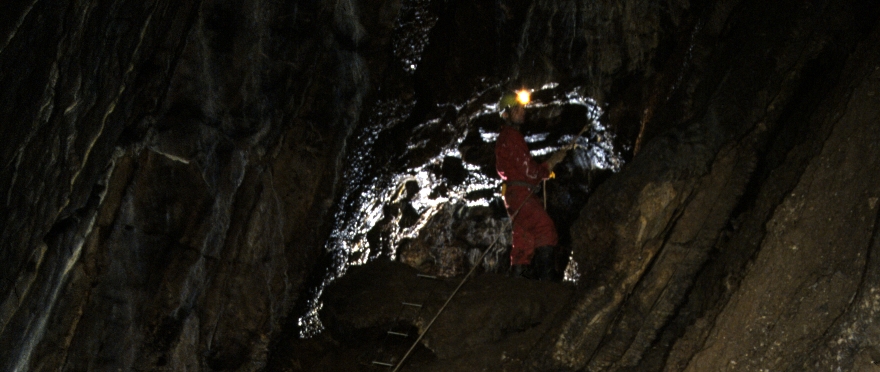The Cave Reopened - then closed again
The cave was not forgotten and continued to be a topic of local speculation and rumour, until, in the mid-nineteen fifties, it became necessary to accurately locate it in order to allow building works to be safely carried out in the area. A geo-resistivity survey was therefore undertaken by Prof. L.S. Palmer, on behalf of Bristol City Council and the cave was once again found. The Eastern entrance was dug open by members of the University of Bristol Spelaeological Society, the Wessex Cave Club and the Bristol Exploration Club during the winter of 1956/57 and the cave re-entered on 12th January 1957. During the following three years, the Cave Research Group of Great Britain surveyed the cave and carried out geological and biological studies. All this work has been well-documented elsewhere (Tratman, 1963).
In August 1961, the entrance was sealed once more, by a concrete slab It remained so for the next thirty years.
Modern Exploration and Study
In 1992, as part of a landscaping scheme for the area around the entrances to the cave, permission was granted by the City Council to reopen the cave and this was done on the 7th February. The method used was to tunnel under one corner of the concrete slab and to position a concrete tube leading vertically down to this. The tube and slab were then covered and surrounded by an artificial hummock of earth and consequently the cave is now about two metres deeper than before. The tube was topped off with a securely lockable lid.
The reopening of the cave enabled up to date studies to be undertaken within it and has allowed further exploration to take place. On the 6th May the traverse into the Upper East Passage was made for the first time. This passage proved to be only thirteen metres long before closing down and to have the characteristic dog-tooth calcite lining, except where this had fallen off the north wall and was lying on the floor. On the 2nd July and again on 9th July the lake was dived. A large passage was found to lead off under the eastern wall of Lake Chamber, but after only twelve metres this ended in a blank wall. No penetrable passage was found leading upwards and any continuation downwards is solidly choked with boulders. The only passage not to have been entered by modern explorers is that said to have been stopped up by the miners in about 1769 It is not yet known whether this exists or exactly where it might be found.
Research work in the cave has continued intermittently since 1993. Studies have been carried out on the tiny and unusual animals found within the cave. This cave is the only cave site where a population of the rare invertebrate Niphargus kochianus has recently been found and is certainly the only cave site where both N. kochianus and N. fontanus have been recorded. Further details on these fascinating creatures may be found on the Hyopogean Crustacea website.
Further studies of the mineralogy have also been undertaken. No more passage has (yet) been found, but modern climbing techniques have finally allowed access to the top of the main chamber for the first time since the 1870s. A radiolocation exercise was carried out in 2007 to ascertain the proximity of the cave to the site of a proposed mobile phone mast. The mast was moved slightly to the south to avoid any problems In May 2015 a full resurvey of the cave was completed down to the level of the lake. This was begun in 2013 to carefully locate the upper parts of the cave in the light of planning proposals in the area. It included a very accurate location of the entrance, carried out by the British Geological Survey and a much more precise survey within the cave, as well.
